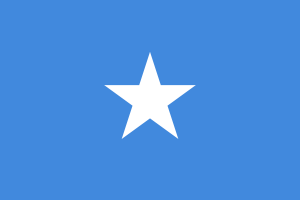Language/Somali/Vocabulary/Meals-and-Dining
| ◀️ Fruits and Vegetables — Previous Lesson | Next Lesson — Greetings and Etiquette ▶️ |
Welcome to this exciting lesson on Somali Vocabulary: Meals and Dining! In this chapter, we will explore essential words and phrases related to meals, dining, and the utensils we use in Somali culture. This topic is vital for understanding everyday conversations and engaging in social settings where food is often the centerpiece of gatherings.
Food is not just sustenance; it's a way to connect with friends and family, a means of celebration, and a reflection of our cultural heritage. By learning this vocabulary, you will not only enhance your language skills but also gain insights into Somali customs and traditions surrounding meals.
In this lesson, we will cover:
Breakfast, Lunch, and Dinner[edit | edit source]
We will begin by discussing the three main meals of the day: breakfast, lunch, and dinner. Understanding these terms will help you communicate your daily routine and preferences effectively.
| Somali | Pronunciation | English |
|---|---|---|
| Quraac | /kuˈræʕ/ | Breakfast |
| Duhur | /duˈhʊr/ | Lunch |
| Casho | /ˈʧaʃo/ | Dinner |
Common Somali Meals[edit | edit source]
Next, we will delve into popular Somali dishes that you might encounter or wish to try. Food plays a significant role in Somali culture, and knowing the names of traditional dishes will enrich your culinary experiences.
| Somali | Pronunciation | English |
|---|---|---|
| Canjeero | /ˈtʃændʒɛːro/ | Flatbread |
| Bariis | /bɑˈɾiːs/ | Rice |
| Suugo | /ˈsuːɡo/ | Sauce |
| Hilib | /ˈhɪlɪb/ | Meat |
| Maraq | /ˈmɑːɾɑq/ | Soup |
| Kaluun | /kɑˈluːn/ | Fish |
| Basal | /ˈbɑsɑl/ | Onion |
| Yaanyo | /jɑˈɲo/ | Tomato |
| Baradhada | /bɑˈɾɑːðɑdɑ/ | Potato |
| Khudaar | /xuˈðɑːɾ/ | Vegetables |
Utensils and Table Settings[edit | edit source]
Understanding the utensils used in dining is equally essential. We will learn the names of common utensils and table settings that you may encounter during meals.
| Somali | Pronunciation | English |
|---|---|---|
| Qasacad | /kɑˈsɑːkɑd/ | Plate |
| Midhis | /miˈðɪs/ | Bowl |
| Fargeeto | /fɑˈɡeːto/ | Fork |
| Mindhicir | /minˈðɪʧɪɾ/ | Spoon |
| Mindhi | /mɪnˈðɪ/ | Knife |
| Khamri | /kɑˈmɾi/ | Glass |
| Sangool | /sɑnˈɡoːl/ | Cup |
| Kaar | /kɑːɾ/ | Napkin |
| Meel | /meːl/ | Table |
| Koronto | /koˈɾonto/ | Chair |
Practice Exercises[edit | edit source]
Now that we have learned the vocabulary, it's time to practice! Here are ten exercises to help solidify your understanding.
Exercise 1: Matching[edit | edit source]
Match the Somali words with their English translations.
1. Quraac
2. Duhur
3. Casho
4. Canjeero
5. Kaluun
Answers:
- a. Lunch
- b. Dinner
- c. Breakfast
- d. Flatbread
- e. Fish
Exercise 2: Fill in the Blanks[edit | edit source]
Complete the sentences with the correct Somali vocabulary.
1. I eat _______ (Breakfast) every morning.
2. For _______ (Lunch), I usually have rice.
3. We enjoy _______ (Dinner) with family.
Answers:
1. Quraac
2. Duhur
3. Casho
Exercise 3: Translation[edit | edit source]
Translate the following sentences into Somali.
1. I love flatbread.
2. Fish is my favorite dish.
3. Can you pass the spoon?
Answers:
1. Waxaan jeclahay canjeero.
2. Kaluunku waa cunto aan jeclahay.
3. Ma iigu gudbin kartaa mindhicir?
Exercise 4: Listening Comprehension[edit | edit source]
Listen to a recording of someone describing their meal. Write down the Somali vocabulary words you hear.
Exercise 5: Conversation Practice[edit | edit source]
In pairs, practice a dialogue about your favorite meals using the vocabulary learned.
Exercise 6: Picture Identification[edit | edit source]
Look at pictures of meals and utensils. Identify each item in Somali.
Exercise 7: Role Play[edit | edit source]
Role-play a dining scenario where one person is the host and the other is a guest. Use the vocabulary learned.
Exercise 8: Vocabulary Quiz[edit | edit source]
Create a quiz for your classmates using the vocabulary words. Include definitions or translations.
Exercise 9: Writing Practice[edit | edit source]
Write a short paragraph about your favorite meal, using at least five of the new vocabulary words.
Exercise 10: Group Discussion[edit | edit source]
Discuss in groups about traditional Somali meals and what they mean to your culture.
Conclusion[edit | edit source]
Congratulations on completing this lesson on Somali vocabulary related to meals and dining! By mastering these words and expressions, you're well on your way to engaging in conversations about food, which is such an integral part of Somali culture. Remember to practice regularly, and don’t hesitate to use these words in real-life situations. The more you immerse yourself in the language, the more confident you will become.
Sources[edit | edit source]
- English-Somali Dictionary | Migration Stories
- English to Somali Meaning of eating - cunidda
- Somali Culture - Etiquette — Cultural Atlas
Other Lessons[edit | edit source]
- Drinks
- Count to 10
- Family and Relatives
- How to Say Hello and Greetings
- Animals
- Colors
- Food
- Modes of Transportation
- Offering or asking for help
- Directions and Locations
| ◀️ Fruits and Vegetables — Previous Lesson | Next Lesson — Greetings and Etiquette ▶️ |

